This Content Is Only For Paid Subscribers
In Part One, guest future of work consultant, Sam Spurlin delves into the evolving dynamics of work, highlighting the challenges organizations face in navigating remote and in-person work environments.
Adaptability through experimentation and iteration are critical to meet the shifting demands of the modern workplace. Additionally, Sam discusses contrasting viewpoints between senior leadership and employees on returning to the office, proposing a hybrid work model while underscoring the importance of leveraging digital tools for collaboration and recognizing the value of physical office spaces for fostering creativity.
Transcript
The only way you can change a complex system, which all organizations are, is through experimentation. It’s through iteration. We can’t know exactly how to fix any given tension.
The before and after is very different. And we’re still navigating that moment but essentially overnight all of our clients had to figure out how to be remote first organizations and none of them were. So that period of time was incredibly disruptive and also in some ways freeing. They had an opportunity to rethink how they actually go about doing work, at least the ones who took a little bit more deliberate approach, which was difficult given the time, given what we were all experiencing in that moment. But some organizations definitely saw this as an opportunity to do something different and now they are trying to figure out as we come back to a little bit more of the status quo, what does that mean? Do you come back full-time to an office building all the time for everyone? Do you do some sort of hybrid sort of thing? Do you stay fully remote? And I think we’re seeing all organizations really wrestle with what that means for them. I see a very strong desire from senior leadership often to go back to as much as what the pre covid times were like as possible. Bring everybody back into the building, let’s be full-time. We need to be sitting side by side to be collaborative to get our work done. And I think you see, to varying degrees, the opposite from more the rank and file. Basically folks saying, ‘Hey, we showed that we could do this for two years, not coming into an office every day. We have potentially made major changes to our lifestyles that are going to make it difficult for us to come in every day.’ And I think there’s a growing middle of people who are very open to a third way, something that is different, something that is not what they were doing before, not coming in five days a week, full-time to an office, but also don’t necessarily want to be working from their home offices full-time either, and are open to coming back in ways that make sense for them, both from a life perspective but also for the work. They don’t want to be coming into an office Tuesday, Wednesday, Thursday and spending all of their time on video calls with their colleagues who are in different offices or working from home on those days. They want it to actually mean something to come into a physical space together. Everybody has their own preferred definition of what hybrid means. I think at the highest level it just means that we’re not fully everybody coming into the office all the time or fully at home or working remotely all the time; that there’s some in between there. You can be advocating for a hybrid way of working that is mostly all coming into an office or you can advocate for something that is mostly remote. There’s no agreed upon definition of what hybrid actually means other than somewhere in this messy middle. Going back to March of 2020 us, we were navigating the covid situation like anyone else. My work was mostly spent going in and working in clients actual physical spaces. I spent a lot of time traveling. We felt like we had to be with our clients side by side in real life in order to do this work. We learned just like everyone else, that actually we can still do really great work when we’re predominantly remote. We were worried at first that we were basically going to lose all of our clients, that everybody was going to be so overwhelmed by this navigating remote work that consulting budgets are easy to cut and that we’d be gone. But what we found is that organizations, at least the ones that we were working with and the ones that would reach out to us realized that it wasn’t, this was not an IT problem that they were trying to solve. Yes, there is an IT component. How do you suddenly have the tools and the services so that people can access sensitive information from home so that they can collaborate. Yes, that’s part of it. But broadly more broadly, what does it mean for our, what we would call the organization’s operating system to be working in this fundamentally different way? And what does it mean in terms of how we relate to each other? What does it mean in terms of how we share information? If we can’t just reliably bump into each other in the halls, do we just forego that spontaneity or are there other ways to create that? So this period of time in 2020 and 2021 created a lot of space to consider how to do things differently and that really was a lot of demand for our work. What’s different is obviously that we’re not back to what we were before. There is a movement toward people moving back into the offices, but I think there’s a realization that you can’t really put that toothpaste back in the tube. In terms we’ve shown that there are other ways of working and we’re seeing with a lot of the tech companies right now, these mandates for back to office, but even a lot of those mandates are three days a week, not fully. So that has still remains as I think a stark difference between then and now. I have a newfound appreciation for digital tools that allow for collaboration in real time looking at shared documents or shared artifacts together. Like we’re sitting around a table, which those tools certainly existed pre covid, but they were not front and center in most organizations toolboxes. Tools like Miro and Mural and all the various white boarding tools. Suddenly I went from never using those to almost having my entire working life living in documents like that. In some ways they are obviously not as good as sitting around a real table with real humans together, but in some ways they’re actually better. Some of the things that you can do when you don’t have to worry about the laws of physics in terms of how we are looking at something together is actually kind of exciting and I’m looking forward to how those things, how the physical and the digital continue to evolve together into the future. When I think about the digital and the physical realms that we now have to habit in our work lives, I think about well, what is each one of those best at? What is best for doing in person with real people, my real colleagues sitting in a room together versus what is best in the digital world and can we be really careful and deliberate about trying to use each of these modalities where it makes the most sense as opposed to just defaulting to one or the other. But five years ago you would default to everything in person because why not? That’s just what we did. And a lot of those things that we did in person are meant to be in person that is the best place to build relationships and have this working so often with tactile things. But now we have this digital area, this digital modality for doing a lot of work too. And how do we save that for the things that are best for that environment? That’s the opportunity that I see for a lot of organizations right now is being thoughtful about how do we come together, whether we’re distributed first and we come together occasionally throughout the year or whether we’re coming in three days a week to an office and two days a week, we aren’t. Either way, you have to start being deliberate about what we can do best in each situation. Even though I have a great space for working from home, I miss going into an office more regularly than I do right now. Whether it’s The Ready’s old office or my client’s office. I miss the energy, the shift from I am stepping out of kind of my personal life and into my work life. There’s a lot of psychological benefit from being able to create different spaces where you inhabit different aspects of your identity. And when you are working from home and living from home, there’s some mixing up there that is not always the greatest. When I think about the office or the office that I wish I was going into every day, I am thinking about obviously collaboration. Human beings we’re social people. We’re social animals. We like being around our teammates, if we generally like our teammates, I miss just running into people and having an idea and saying, ‘Hey, let’s grab this conference room. We both have a spare hour. Let’s go work on this thing that we have shared work between us.’ There is a lot to be said for physical spaces that inspire you to think differently, to actually knock you off of your normal equilibrium so that you have that creativity, that inspiration that is not just a given when you’re surrounded by your everyday sorts of spaces. When I think back to the Ready’s early days when we had an office, a table and a stack of paper and some stickies could get us a long way down the path. It doesn’t have to be fancy, it doesn’t have to be this interactive wall where we’re going to project things and have a minority report sort of situation. No, an empty room with some good paper and some good supplies and the time and space to actually work together with people. That sounds like heaven. I don’t think organizations are actually changing all that much, at least structure wise as we look at this moment. I do think the way work is getting done is different and the way people are interacting with each other is certainly different. But when I think about organizational structure and the lines and boxes on an org chart or how an organization will visualize itself, there hasn’t been a lot of change and I think that’s part of the challenge or part of the problem. There probably should be more change, more of a understanding or respect that the fundamental nature of work is evolving and the way that we visualize or conceptualize organizations should probably change as well. The basic organizational chart, a lot of the basic organizational structural components are unchanged for 50 years or more, and the world is changing around us. There are some organizations that get that, understand that and realize they need to change themselves along with the times and there are others that are pretty solid, pretty unchanging in how they structure themselves. That is creating stress that is showing up in terms of employee engagement, in terms of productivity and they’re having trouble navigating this moment because they aren’t structured to be more adaptive. That tayloristic operating system that really developed during the industrial era is not fit for purpose, for a world that is changing so much more rapidly. The internet, communication tools, just everything that is going on that organizations have to react to and be a part of, it’s so different than it was a hundred years ago. So why would we use the same assumptions, the same principles for what it means to be an organization in 1920 with 2020. That touches everything that affects everything, the structure, the way we meet, how we think about authority being distributed in an organization, what it means to what we think about mastery in an organization. These are all the parts of the organizational operating system that our work tends to touch. Idea of an organizational operating system really uses the idea of an operating system in any sort of computer, any sort of technical device as an analogy for what is going on within organizations. So if you think about your computer, your computer has an operating system that the software you actually interact with rides on top of. You’re very rarely if ever actually interacting with the fundamental code that comprises your operating system but everything you do see and interact with rides on top of that code. So let’s bring that idea to an organization. The operating system of an organization are those unseen principles and assumptions and beliefs and practices about what it means to work in this organization. It’s things like I said before, purpose, strategy, meetings, information, all of these various areas of an organization. We have assumptions and beliefs and principles about how we do these things and how we think we should do these things. For most organizations, they haven’t really thought about it in that nuanced way. You have this black box called ‘culture’ or just the way we do things here and a lot of our work is trying to shine a light into that black box and see what the various parts are so that we can start to ask questions of it and actually experiment our way into doing those things differently. Are we okay with the way that we think about organizational and team purpose here? Or perhaps we want to actually make it something that is useful and helps us make decisions within the organization. Something like meetings, are we okay with what it means to have a meeting here? And perhaps is there a better way for us to meet and what are those assumptions that we need to change those practices? We need to learn to have a better meeting culture. And once you start looking at these various fields of an organizational operating system, you just start to see so many opportunities for experimenting your way into a better way of working.
Read the Full TranscriptThe Opportunity (1:04)
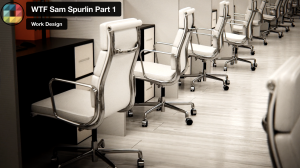
A Third Way (2:17)
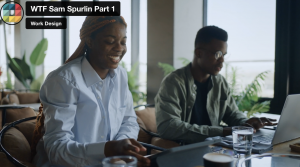
The Messy Middle (3:42)
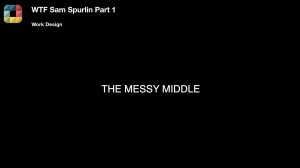
It’s Not an IT Problem (4:23)
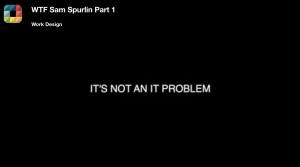
Physical & Digital Together (6:15)
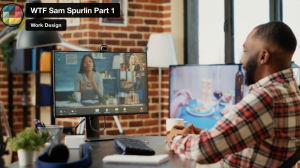
Be Deliberate with the Best Tool (8:04)
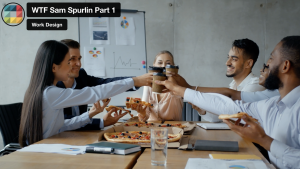
Space That Inspires (9:35)
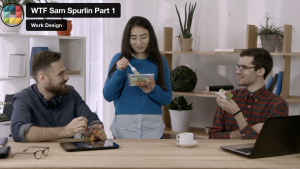
A Table, A Stack of Paper, & Some Stickies (11:13)
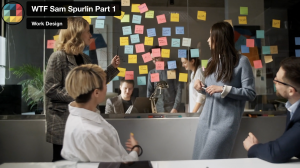
Work is Changing. What about the Organization? (11:48)
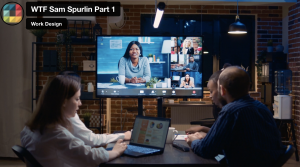
It was so Different 100 Years Ago (13:24)
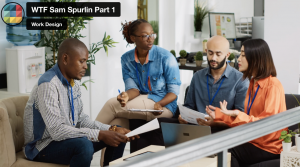
Is there a Better Way? (14:22)
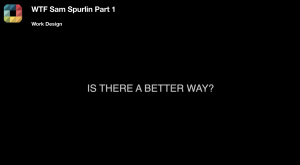
Feeling Inspired? Here Are the Actions You Can Take Now:
- Sit down with your team and a blank copy of the [OS Canvas](https://medium.com/
the-ready/the-operating- system-canvas-420b8b4df062). Ask yourselves, “What is getting in the way of us doing the best work of our lives?” and talk about where those tensions are showing up in your organization’s OS. - Think about what it means for your organization to be fundamentally People Positive and Complexity Conscious. What of your current policies and ways of working are NOT this way
- Identify one experiment that you could lead within your team or organization. What’s your hypothesis? How will you know if this experiment is successful? How can you get started with it as soon as possible?
Resources:
- TheReady.com
- Brave New Work by Aaron Dignan
- The OS Canvas from The Ready’s blog
- Hybrid Work Isn’t a Problem to Solve from The Ready’s blog
Meet Sam Spurlin:
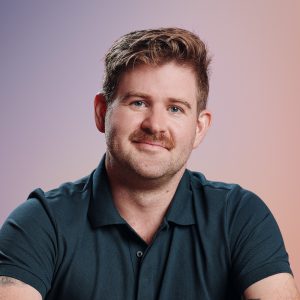 Sam Spurlin is a partner and the first employee at The Ready, a future of work consultancy. Over the past eight years he has partnered with and advised many organizations on their journey toward more people positive, complexity conscious, and effective ways of working. He has worked with senior leadership teams from GE, FreshDirect, Lockheed Martin, Pacific Gas & Electric, MITRE, Ritual, Les Mills, and others. Prior joining The Ready he consulted with David Allen on the updated edition of his bestselling book, Getting Things Done, and published with Dr. Mihaly Csikszentmihalyi on the future of work and positive psychology. He lives in Arlington, Virginia with his wife.
Sam Spurlin is a partner and the first employee at The Ready, a future of work consultancy. Over the past eight years he has partnered with and advised many organizations on their journey toward more people positive, complexity conscious, and effective ways of working. He has worked with senior leadership teams from GE, FreshDirect, Lockheed Martin, Pacific Gas & Electric, MITRE, Ritual, Les Mills, and others. Prior joining The Ready he consulted with David Allen on the updated edition of his bestselling book, Getting Things Done, and published with Dr. Mihaly Csikszentmihalyi on the future of work and positive psychology. He lives in Arlington, Virginia with his wife.
Episode 7 Part 1 Credits:
- Created By Bob Fox
- Produced By Work Design Magazine
- Directed By Bob Fox
- Edited By Katie Sargent & Bob Fox
- Special Thanks to Amanda Gram

